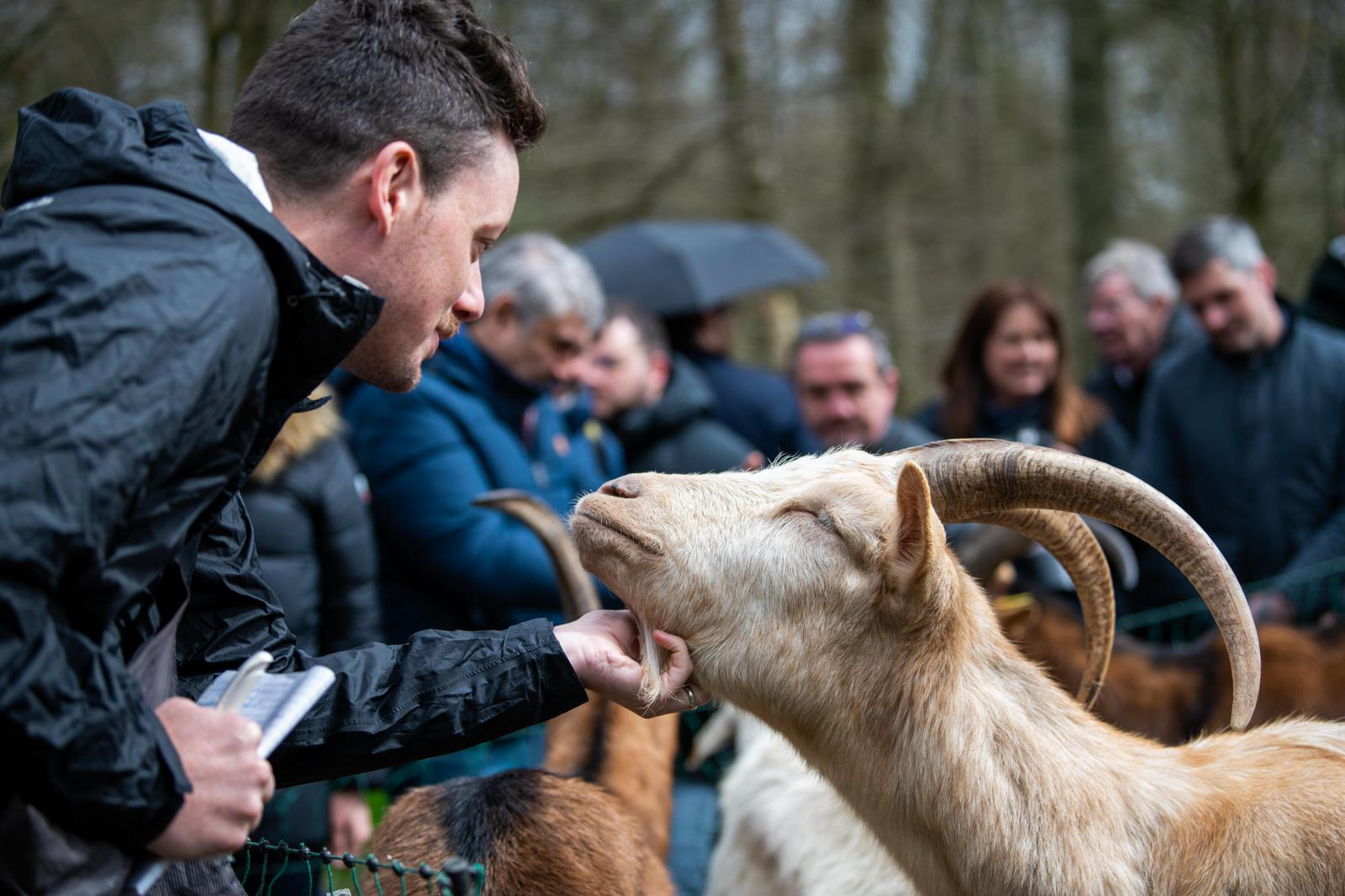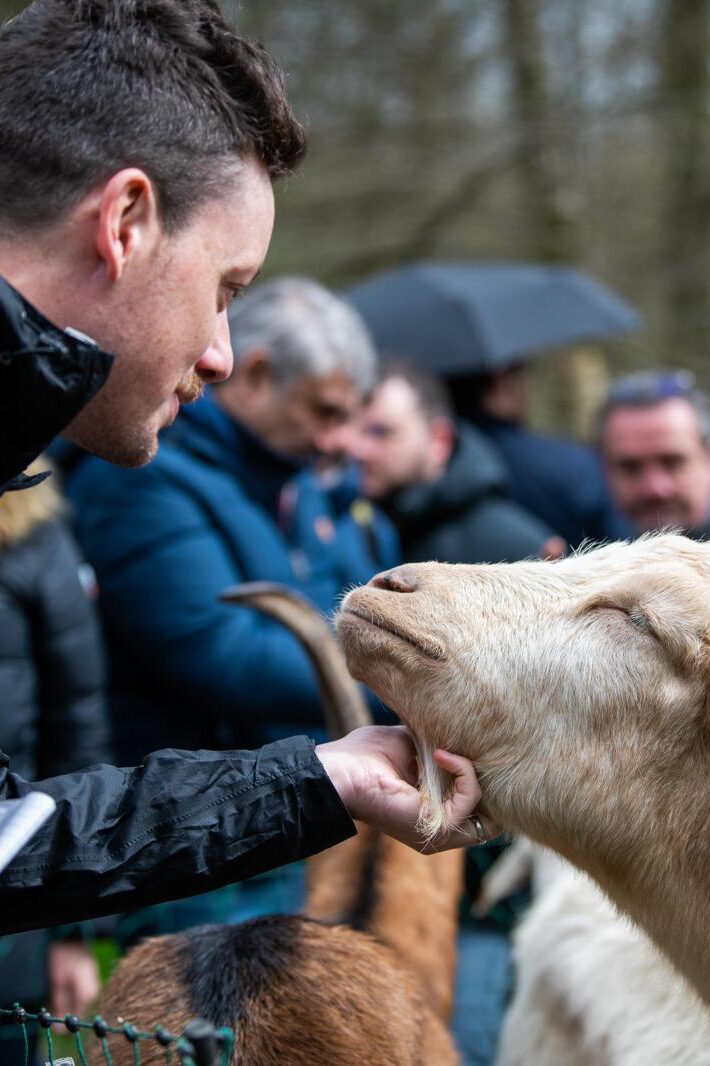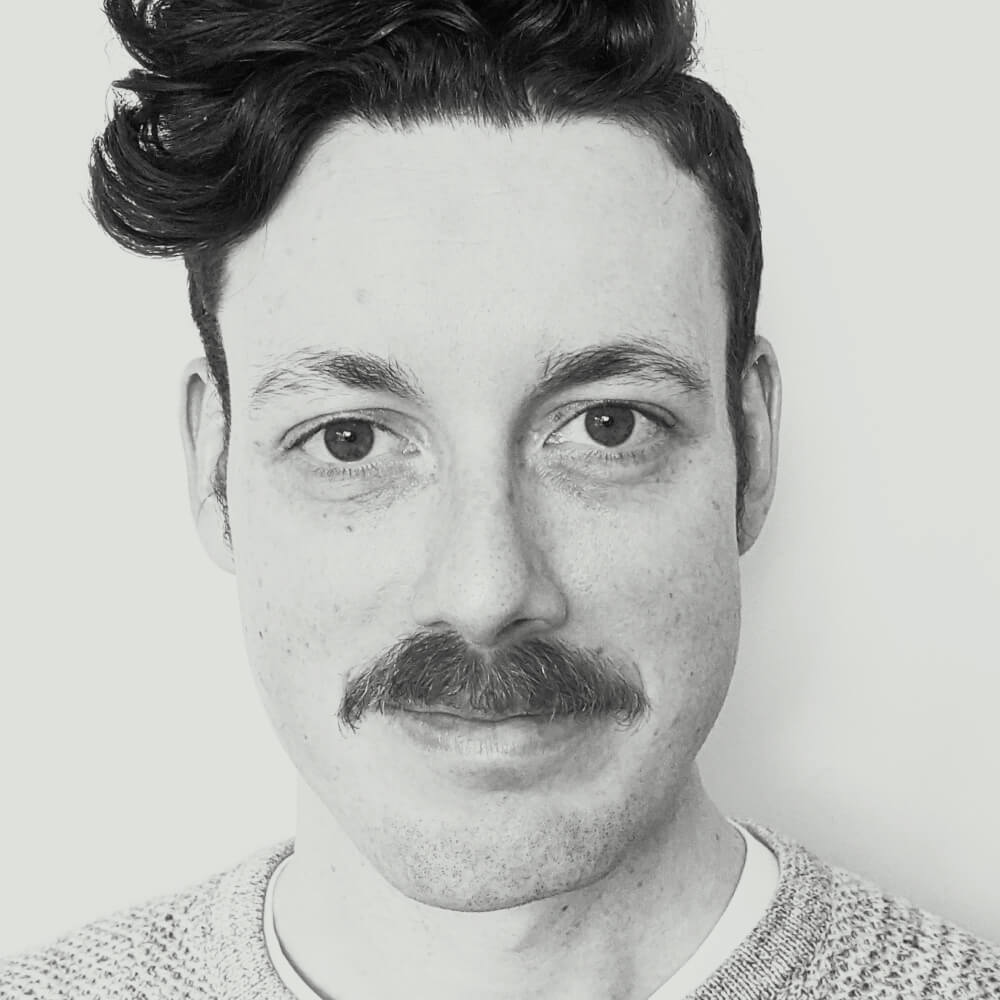Our journey begins early – too early – at Kortrijk Station. A machine-made coffee. A pastry. A wait in the dark for a train. We have a date with a big blue Shimano neutral service car in Lille, across the French border, to ride along with the Amis de Paris-Roubaix (Friends of Paris-Roubaix) on their final cobbles inspection before the big day this weekend. A very nice Shimano PR man in a very small rental BMW picks us up at Lille station, a drowsy 40-minute train ride down the line, and we zip our way south toward the world’s most famous cobbles.
Around 9 AM, we pull up at the Chez Françoise, a brown brick building in a small town in rural France. On the outside are two arrows – one facing left saying Roubaix; one facing right saying Paris. We walk through the door to a handshake from a couple of cyan-jacketed Shimano staff and find ourselves surrounded by about 50 French people of that bygone era of Frenchness, the type you find increasingly less these days, the type that refuses to speak English to you even if they could, which they can’t.
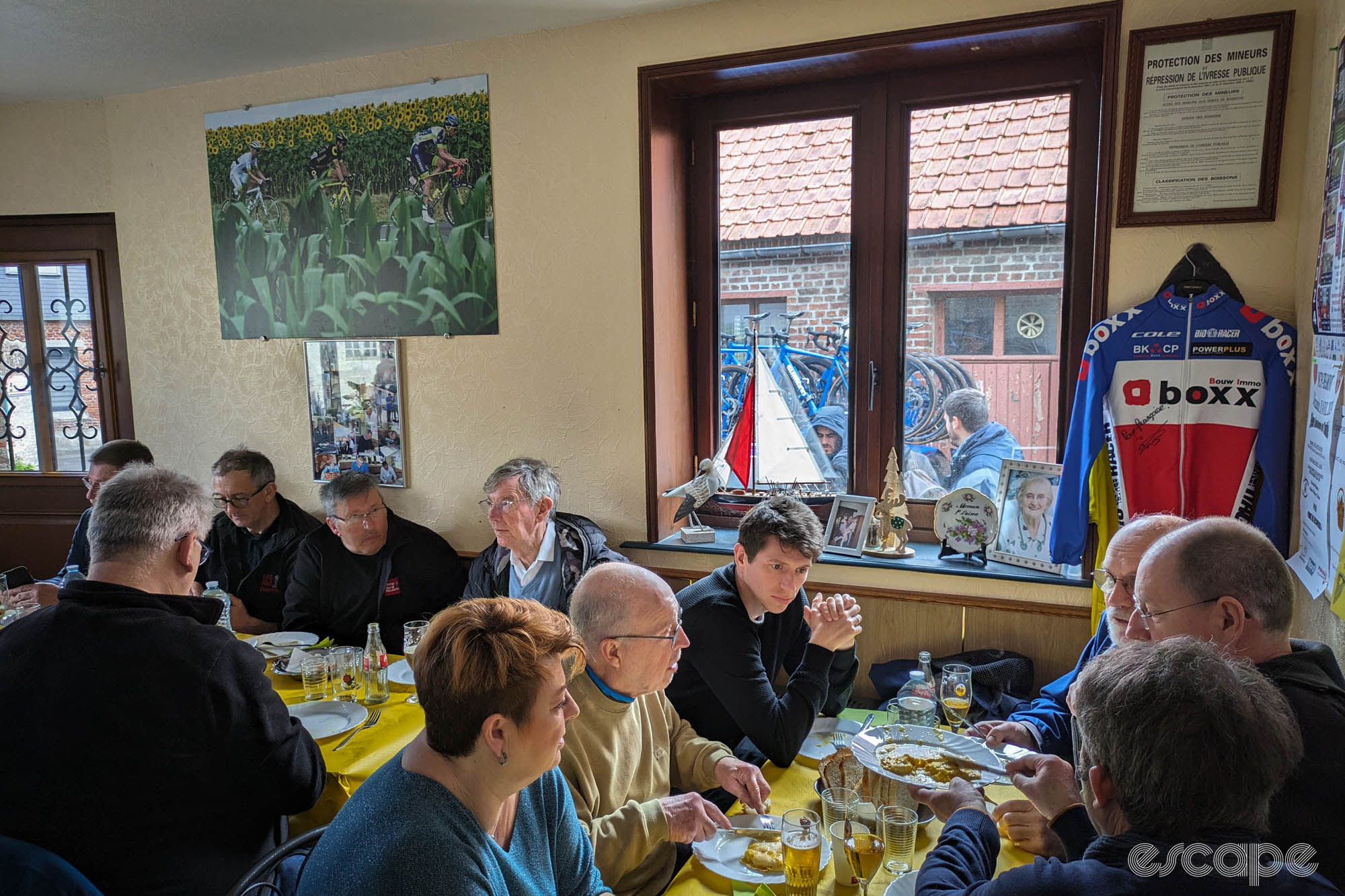
There are several long tables with people of mostly-advancing years sitting at them, having little breakfast beers with their plates of omelette that are conveyed from the kitchen by another elderly man. These are the Amis de Paris-Roubaix – an organisation of volunteers who tend the cobbles, grade their difficulty and get them race-ready. I’ve never quite understood the phrase “salt of the earth” but it feels like this is probably a good place to apply it.
There’s a curved bar against one wall, a Thermos full of coffee, and a menu of cheap prices for spirits I’ve never heard of. The decor is Paris-Roubaix themed, some photos of grandchildren, and a vast framed jigsaw puzzle on one wall leading through to what seems to be the rest of the owner’s house. I order a big coffee, forgetting momentarily I’ve crossed the border into France. I want a lot of coffee, but my crucial blunder is that now I have more of the bad coffee to drink.
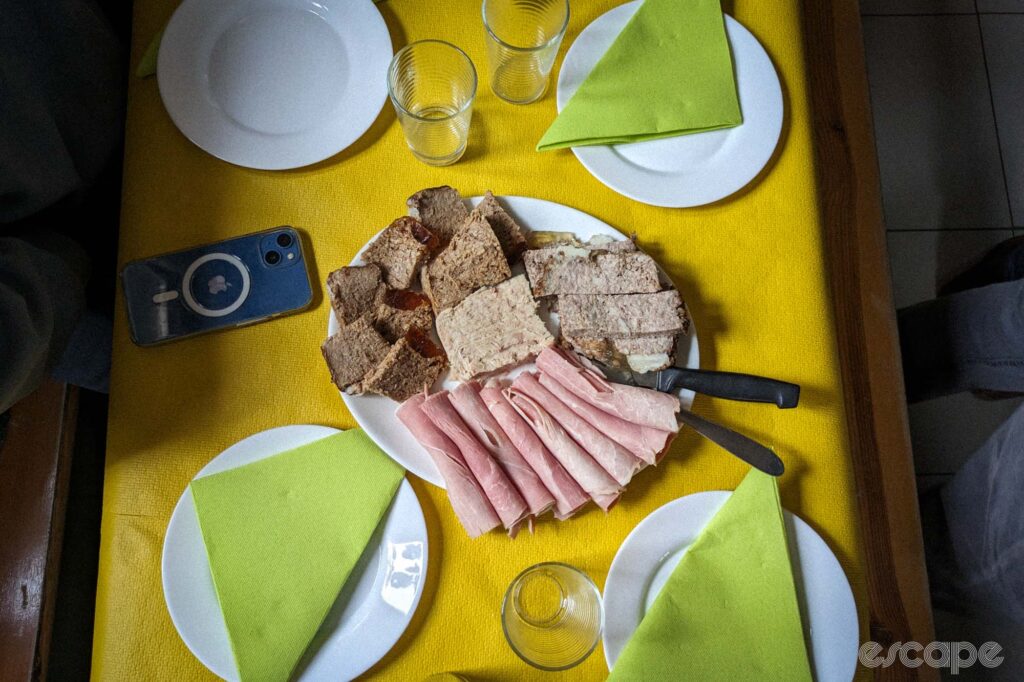
“Why won’t you eat the meats?”
“We are waiting for the omelette.”
“Ah. Ok.”
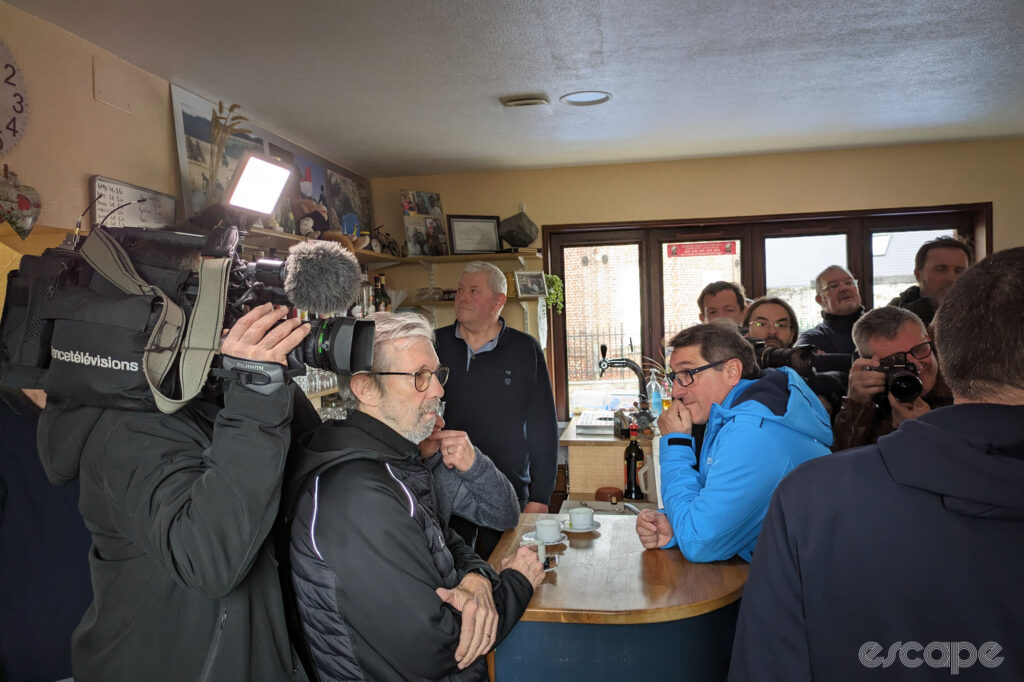
Suddenly there’s a flurry of activity, and a range of French media types rise from their own meats, cheeses and omelettes (very fluffy, weak yellow, popping halo of bubbled oils, 10/10) and train their cameras and microphones on an old woman and an old man standing in the centre of the room. From what we later learn, they’re paying tribute to the recently-deceased Amis de Paris-Roubaix president, Francois Doulcie; there’s not a dry eye in the French-speaking portion of the house. A young journalist from the local paper comes over to talk to us afterward, very insistent on figuring out whether we like the French cheese. We confirm that we do; he is surprised enough at this revelation that he writes down our names, home countries and website in his little notebook with a hot-pink biro so that he can include it in his next dispatch.
Formalities completed, everyone leaves the bar. We are introduced to our driver, Bruno Mallet, the head of Shimano neutral service in France – the point man for the mechanical needs of all of ASO’s races, from the Tour de France to Paris-Roubaix to the Tour of Oman. On Saturday and Sunday, he says, there will be four Shimano cars with eight bikes apiece on the roof, about as many spare wheels, four motorbikes with more wheels and two vans with more supplies strategically positioned around the route. Seeking further context from someone that can, say, understand the language, I try to draw some answers out of Bruno about the speeches in the bar. “It seemed like everyone was quite emotional …”, I offer as an opening gambit. He responds: “OK. We go.”

Following at the back of a convoy of French media vehicles, ASO cars and Amis de Paris-Roubaix-driven vans, we make our way under leaden skies through the first cobbled sections we’ll inspect, stopping occasionally along the way. One sector sends the air conditioning vents in the car’s cabin rattling, as Bruno explains the technique of driving the cobbles. The crown of the road sits high enough that you can’t drive down the middle, otherwise the bottom of the car will hit the cobbles when it bottoms out. “On recon day it’s easy,” he assures us. “On race day, not so much.” Then, as if to underscore the point, the car bottoms out. Gonk. He gives a little chuckle.
“Have you ever broken a car?”
“No, no … there is a metal plate under the car for Roubaix and we pump the tyres up to the maximum pressure – the riders’ tyre pressure goes down, but we go up.”
“How fast do you go on race day?”
“Sometimes 60, 70 [km/h] …”
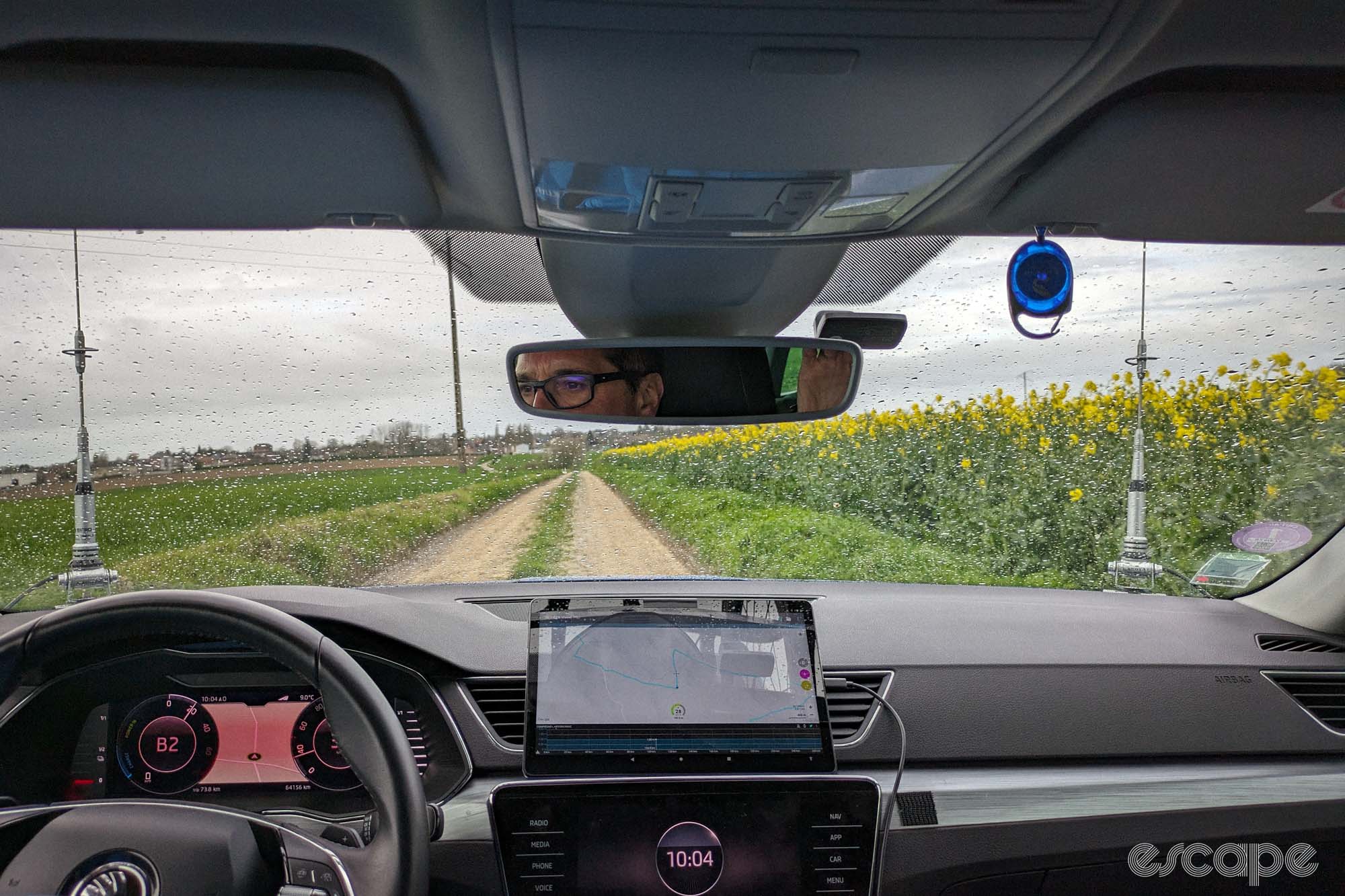
At this stage we’re trundling along at a relatively sedate 40, and at our request Bruno puts the foot down to show us what that’s like. Every so often the car gives a playful little wiggle from side to side as it drifts on the slick cobbles, and there’s a constant hum from things vibrating inside and outside the car. Today there are no other cars, no other riders, no thousands of screaming spectators lining the roads: on the weekend, the margin for error is small and the consequences are big. I’m grateful to be in the back seat of a car driven by a man who knows exactly what he’s doing. Even so, you can’t help but think of what might happen if things go wrong.
The day see-saws between reminders of this bleak reality and a kind of gentle absurdity. In the former camp: a solemn stop at the roadside memorial for Michael Goolaerts, a young Belgian rider who lost his life in the 2018 edition of the race, victim of a heart attack. There’s a plaque, some bottles at the base, some terracotta pots full of daffodils.
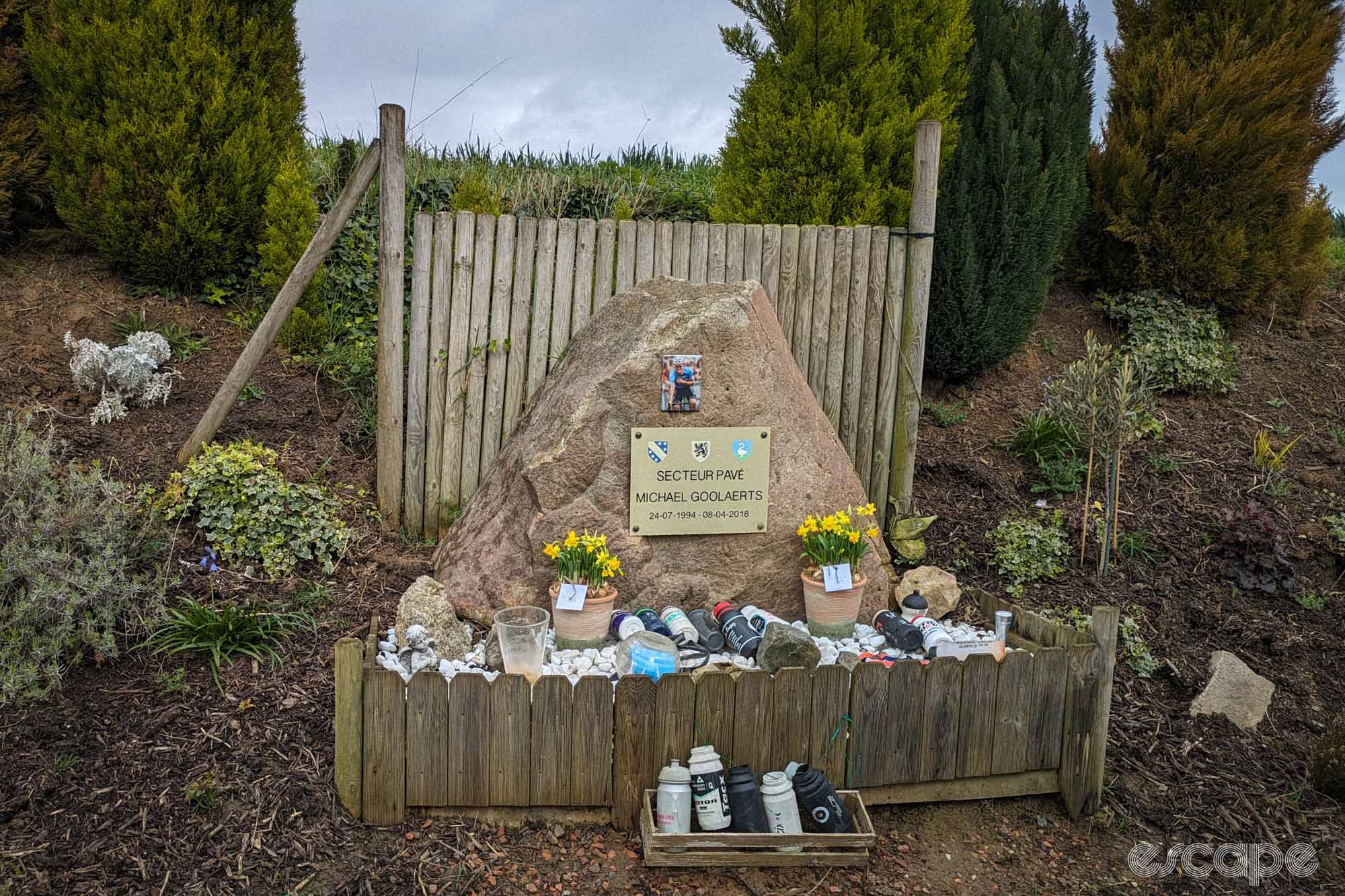
At the other end of the spectrum is a press conference we’re diverted to in Denain, the town that is the starting location for the women’s race. In a room on the top floor of a basketball stadium, overlooking the court, two plastic folding tables are set up for three officials to sit behind. Journalists and a bored kid tagging along with his journalist dad mill about, talking amongst themselves. The ASO and local authority guys try to start their entirely-in-French press conference, but they’re unamplified and can’t make themselves heard until a coordinated shushing campaign from some of the more earnest members of the press corps finally lets them cut through.
Noting this is very much a “me problem” rather than on the ASO, it doesn’t make much difference for my comprehension. The sum total of words I can make out are – in order – Ellen Van Dijk, Marion Rousse, Laurent Jalabert. I spend the remainder of the press conference trying to connect the sides of that particular triangle, before concluding that maybe I’ve just eavesdropped on a lengthy discussion about how all three of them are a bit of a vibe.
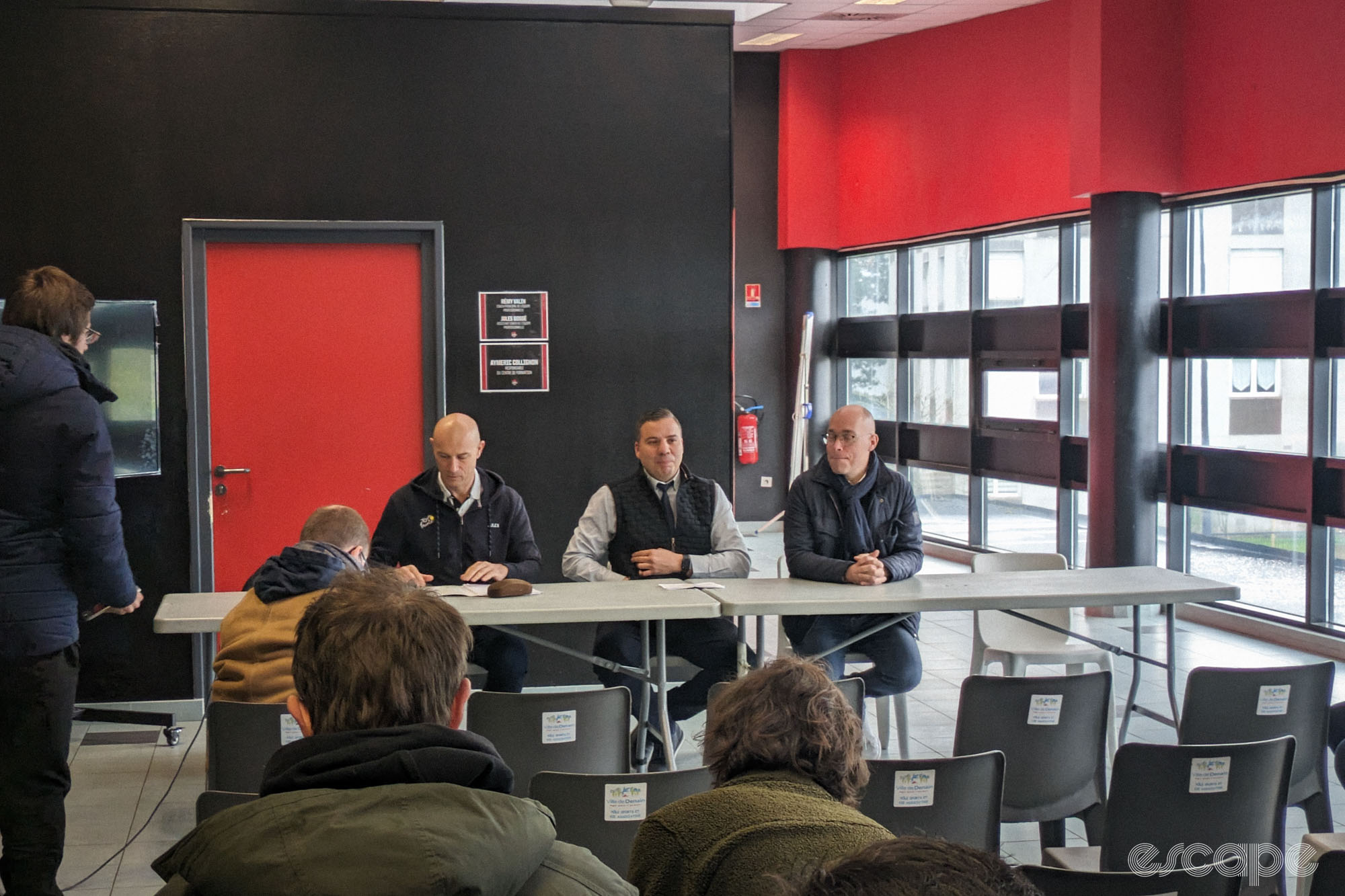
By this point, our schedule for the day has thoroughly blown out; we’re a couple of hours behind where we thought we’d be, and after piling back into the car, the cobbles keep coming. It’s numbing, even in a car; I can’t imagine riding the thing. When the rattling stops there are little glimpses of working-class France on the roadside. In Denain, a town worker with a big blowervac thing pointlessly blasts cut wet grass into the bushes. In some town later, stopped at a construction site, an old man carries a big lump of stone to a gap in his front fence, and hits it over and over again with a hammer to break it up into chunks. Waiting for a gap at a later intersection, four or five enormous draught horses get the wind up their tails and skitter about jauntily, running at the fence before swerving away at the last possible moment, hooves about the size of my head.
At the four-star Haveluy sector, we see how the sausage is made on the cobbles – the work that leads to the star-rating, a figure produced from a complicated calculus of length, elevation, position in the race and inter-cobbler space. Amis de Paris-Roubaix oversees the maintenance, but enlists many volunteers into the effort too. Here, a bunch of local trade-school kids, with brooms and spades and little portable street sweepers, stand slopping mud off the road. Local media seems very into this. I stand on the raised grassy verge, watching ASO staff skating around on the slick cobbles, turning their pristine white trainers brown. A brisk wind sends ripples across the dead-flat fields – green grass, brown dirt, grey skies, uninterrupted for kilometres other than a nuclear cooling tower to the left and the forest of Arenberg and its rusting mining infrastructure to the right.
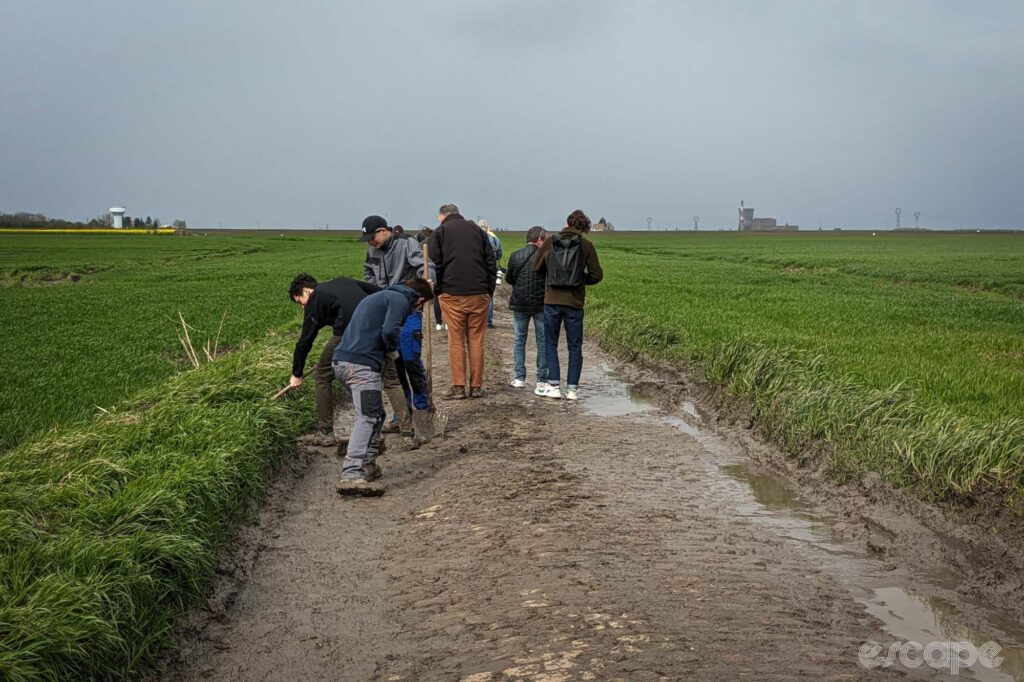

A Peugeot station wagon with a stressed driver clumsily navigates through the media throng, and then we’re all piling back into our cars and heading along the sector, slopping mud back across the cobbles the teens had so effortfully scrubbed. The mud gets worse – at points puddles fill half the road, too deep and dirty to know what rim-rupturing horrors lurk beneath. “It’s difficult to clean … it’s too much, no?” says Bruno, flicking a finger from his wheel toward the slop ahead. He thinks it’s as bad as the wet 2021 edition, and is sceptical that the unseasonable warmth forecast for later in the week will do too much to dry things out.

Eventually we arrive at the Arenberg forest, which – fittingly enough – has a Francois Doulcie face decal on the road just ahead of the cobbles. It’s the day before the course is rerouted, and I see the straight downhill run past the trainline, onto the cobbles. It’s my first time here after years watching it on TV and I can feel the weariness of the region, the old mining equipment towering beside the road. I can also confirm, having eyeballed it, that the new route is very fucking stupid.
Musing on the visceral realities of bodies crunching into cobbles and fences, there’s comic relief in the form of the 50 or so goats that are roaming about in two fenced-off areas on the cobbles, mowing the grass from between the stones. There are little hairy goats with beards. There are medium-sized goats with enormous horns that they turn to scratch itches on their backs. The goats that most have my attention, however, are these really tall ones, at a scale I did not think was an option, kinda half goat, half deer, with wiry hair and sunken haunches. While the little goats are running about skittishly, occasionally rearing up on their rear legs to butt heads, the big guys mostly just stand there vacantly.
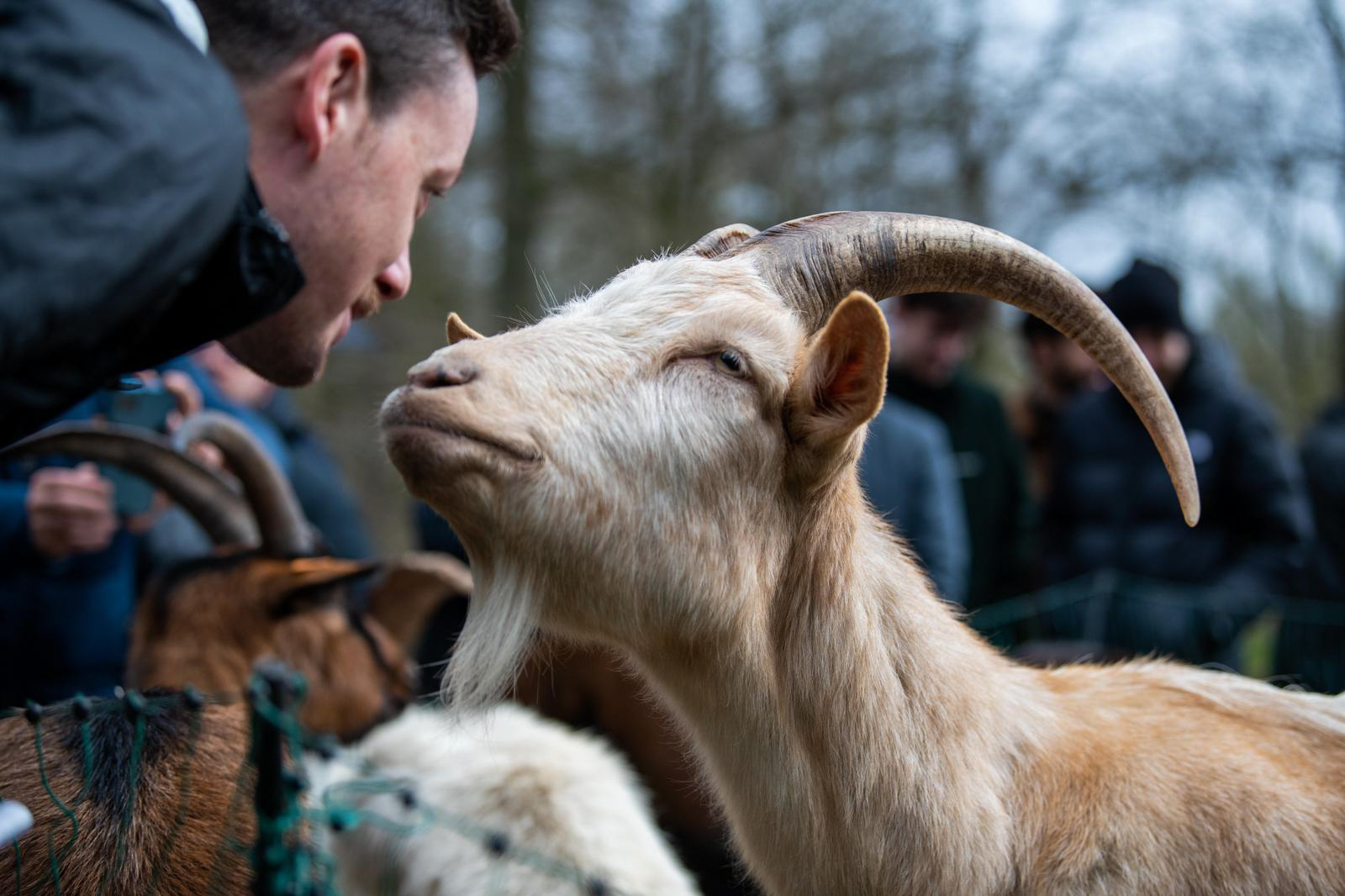
I find a connection with a golden-coloured one who has a yellow tag on its ear, giving it the catchy name of #30061. We stare into each others’ eyes, and I feel its warm breath on my face as I rub it under the chin. If you happened to tune into local news on Tuesday night, you can probably see me and Jonny in the background of another interminable/indecipherable press conference, directly behind race director Thierry Gouvenou, schmoozing with #30061 and then losing our minds as it ambles off to try and chew the jacket of a visibly-repulsed local radio reporter.
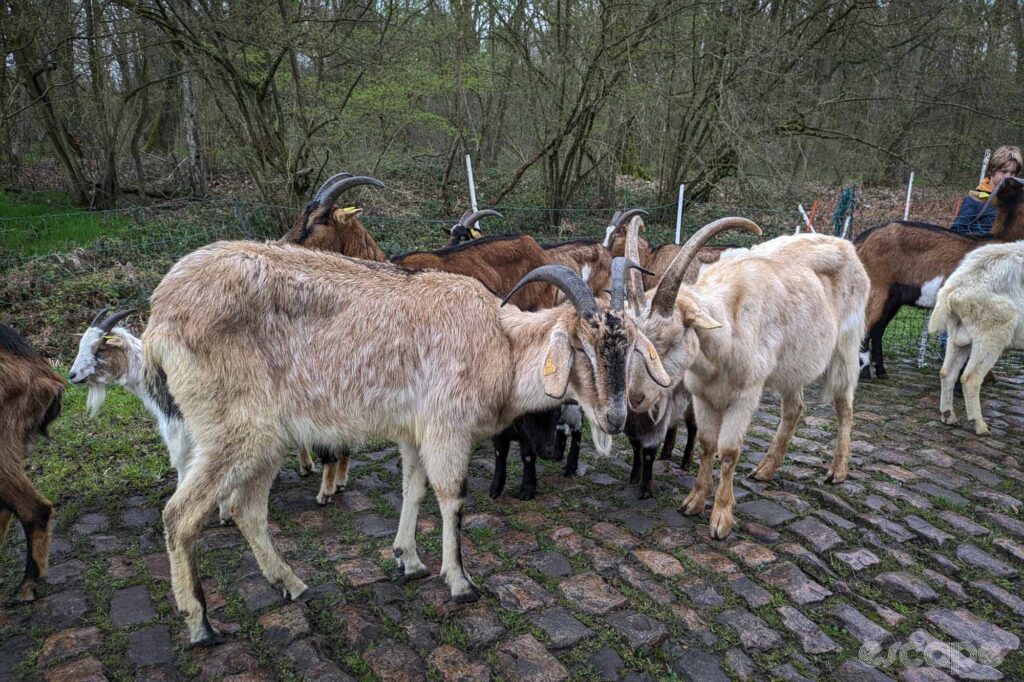
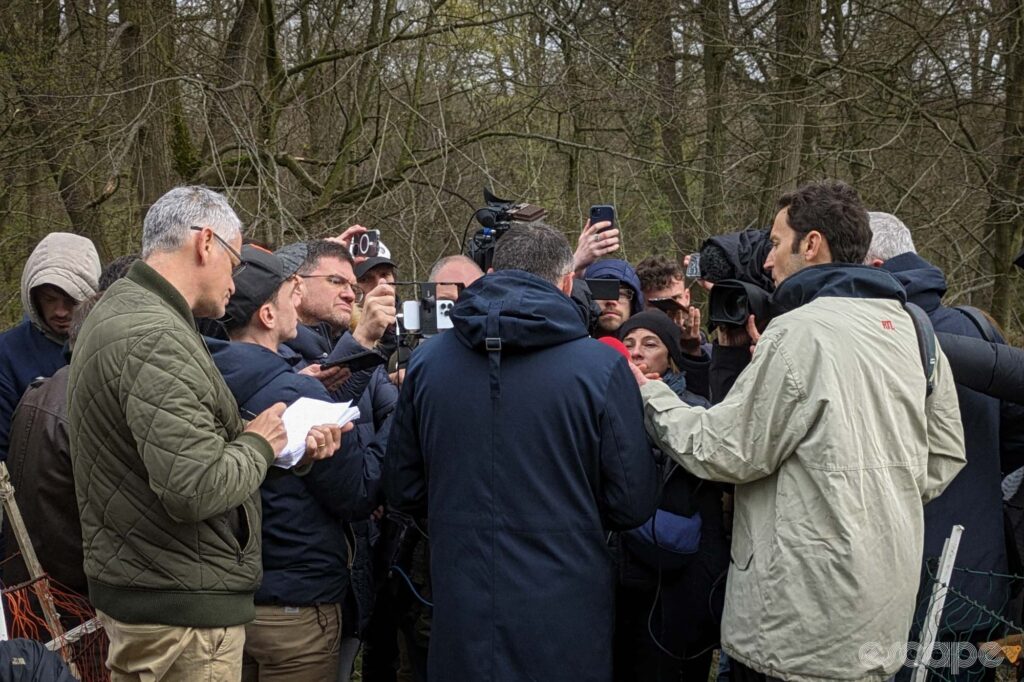
The crowning moment of this day on the cobbles is an Arenberg “experience” riding bikes provided by Shimano. As experiences go it’s a memorable one, by which I mean I’m both glad that I did it and never want to do it again. I ride a fair amount of cobbles at home but they are not like these cobbles, which are too irregular, too broadly spaced, off-camber as soon as you’re off the crown of the road, and treacherously slick. I rattle down under the bridge for a few hundred metres, inflict untold testicular trauma in the process, turn around, and bump back up the hill. Progress is a challenge.

After a couple of down-and-backs like this I’ve probably ridden a total of one half of the Arenberg Forest sector, if that, and I feel every centimetre of it in my lungs, my shoulders, my legs, my hands. I gratefully hand the bike back to our Shimano hosts who put it on the roof of a once-blue car that is now mostly brown. As we get in to drive off, a little barrel of a Jack Russell strains at its leash, unleashing a volley of yaps at a distinctly uninterested flock of goats.
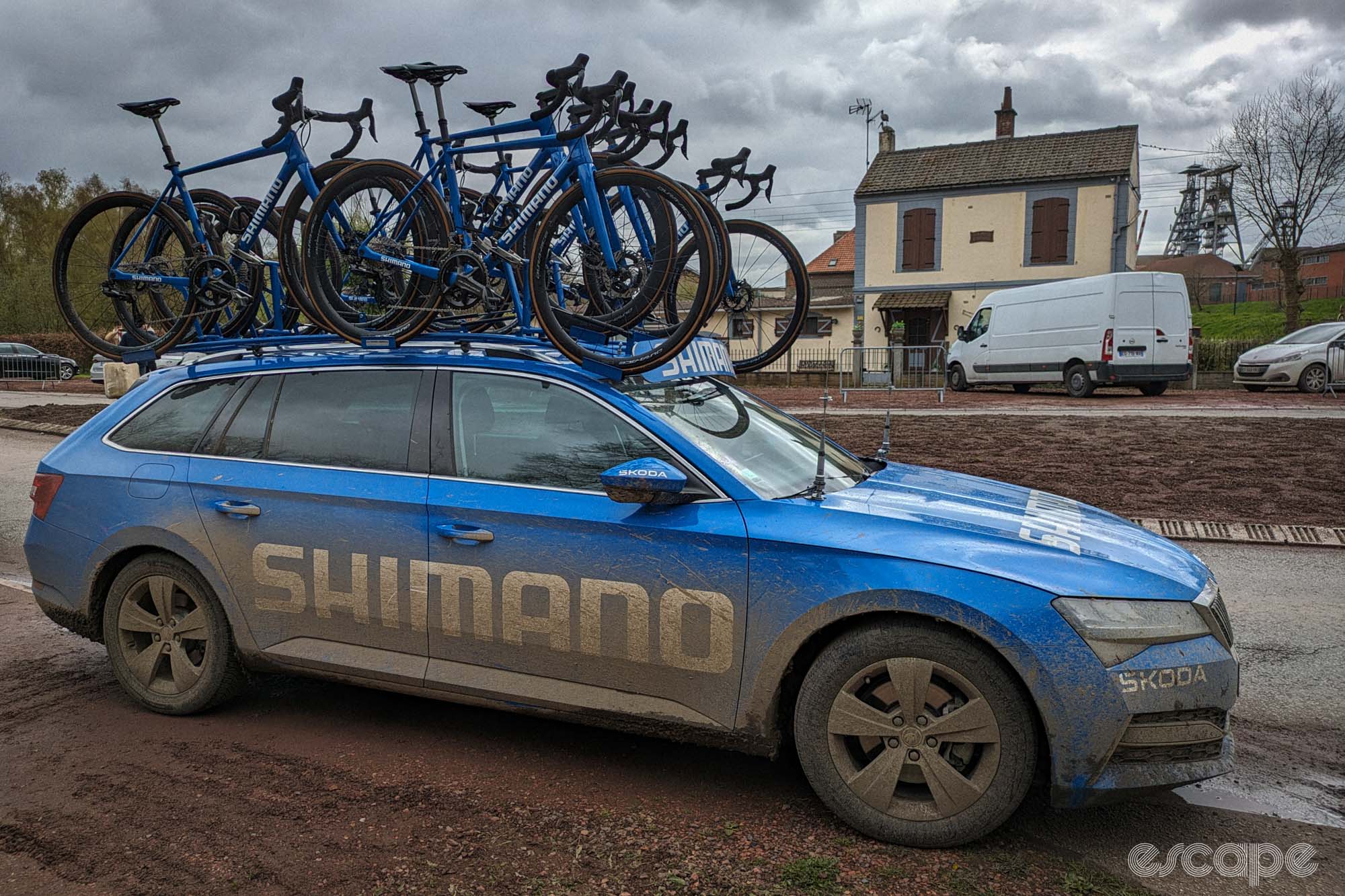
On the way from Arenberg back to Lille, we’re all kind of dazed and tired in the car. There’s been a lot to take in, and many hours of it; like the race itself, just driving part of the route and feeling the rattle of the route has been kinda attritional. Paris-Roubaix is an icon of cycling, maybe its most famous one-day race, with a bleak beauty all its own, but it’s not just the landscape that defines it. It is bound up in the region, tended by its people, fully of its place and space: the brown-brick grit, the industrial ugliness, the warmth and love of its custodians.
What did you think of this story?
